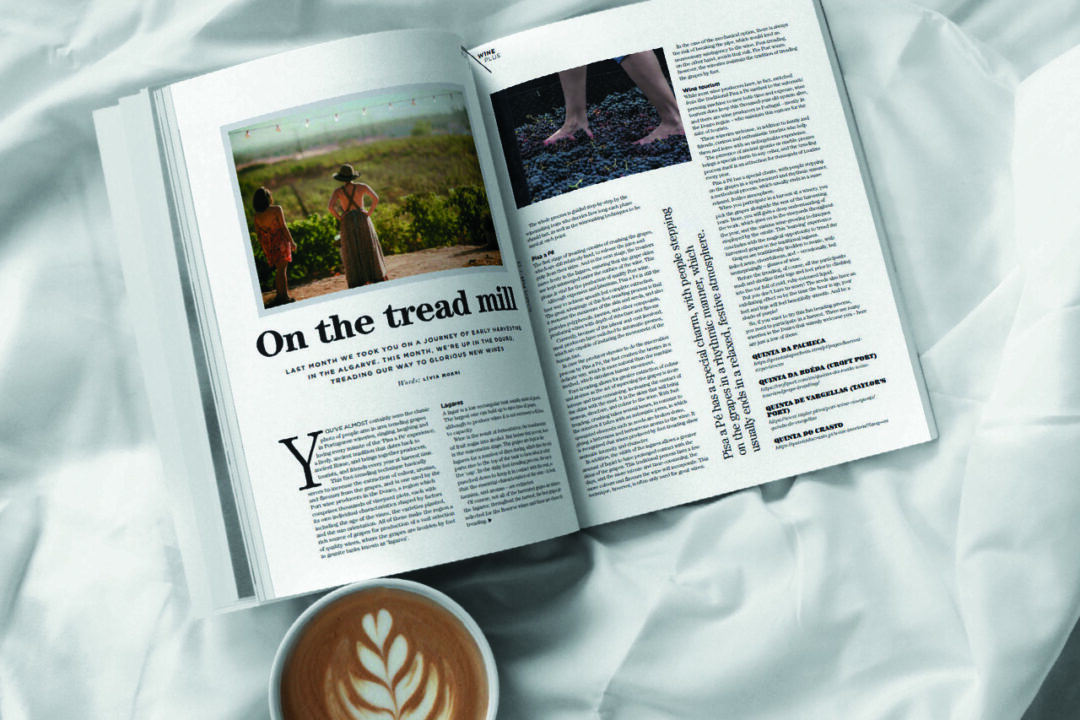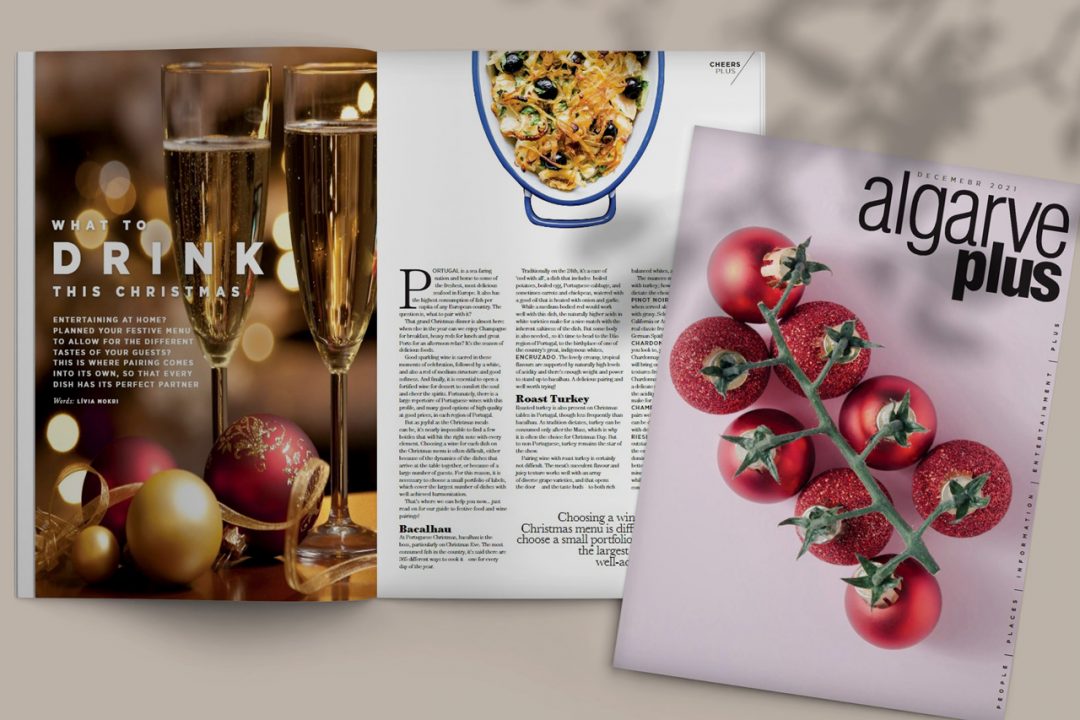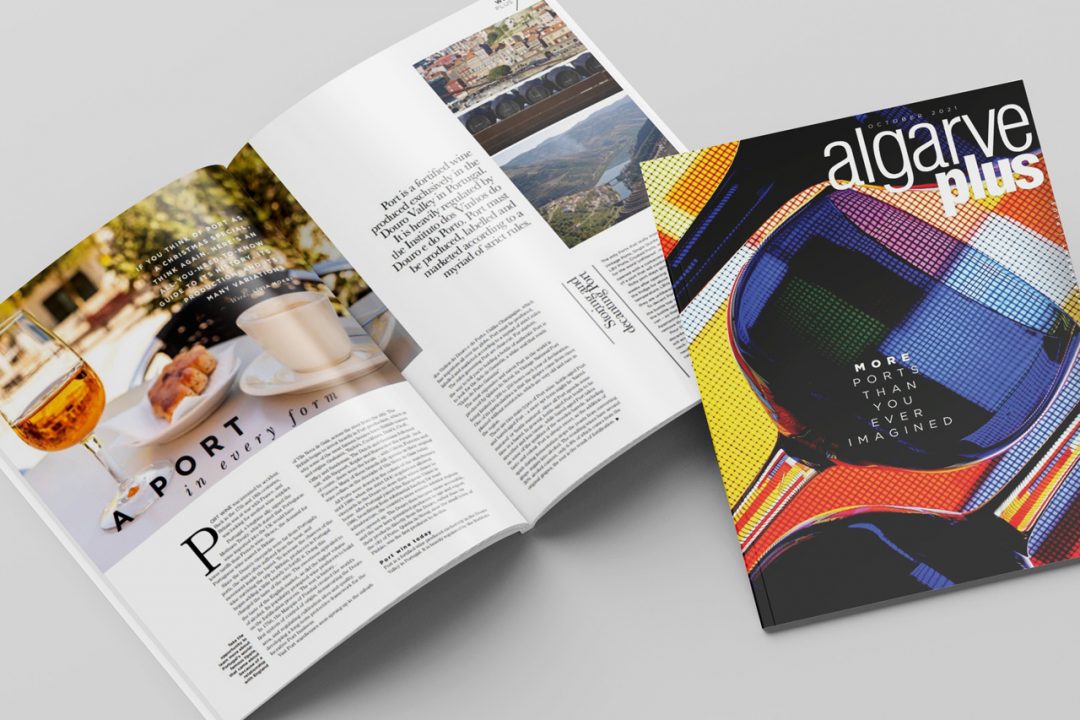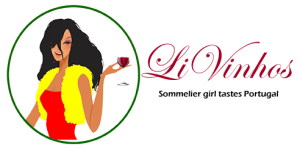On the tread mill – Last month we took you on a journey of early harvesting in the Algarve.
This month we are up in the Douro, treading our way to glorious new wines.
I am happy to share that the September issue of the Algarve Plus Magazine has already been published, with my new writing!
The magazine is readable online or downloaded for free here.
Enjoy!
Or read here the whole article:
On the tread mill
If you’re interested in wine, you’ve probably seen the classic photo of several people arm in arm treading grapes in Portuguese wineries, singing typical songs. It is the foot-treading (named ‘Pisa a Pé’ in Portugal), a lively, ancient tradition that dates back to ancient Rome, and that brings together producers, tourists, and friends every year at harvest time.
Since this foot-treading technique basically serves to increase the extraction of color, aromas, and flavors from the grapes, mostly is well-presented at the Port wine producers in the Douro.
The Douro wine region is made of thousands of vineyard plots, each of which with its own peculiar characteristics including, amongst others, the age of the vines, the varieties planted, and the sun orientation. All of these make the region a rich source of grapes for production of a vast selection of quality wines, where the grapes are trodden by foot in granite tanks known as ‘lagares’.
Lagares
A lagar is a low rectangular tank, of variable size, mostly made of granite. Each winery has more huge granite lagares with different capacities. The largest one can hold up to nine tons of grapes, however, in order to produce wines, it is not necessary to fill them to capacity.
You probably already know that the wine is the result of fermentation, the transformation of fruit sugar into alcohol. But still before fermentation, a process called maceration takes place: the grapes are kept in the lagares for some days while for some hours a day, a team of people (they can be tourists as well) treads them.
During these days, the solid parts of the grapes rise to the top of the tank where they form what is called the cap. So, the foot-treading process the cap is punched down to keep it in contact with the must so that the essential characteristics of the wine, its body, tannins, and aromas are being extracted.
What will define the color of the wine is the time that the must (grape juice) is in contact with the grape skins. The color is in the skin of the grapes, as well as countless other substances, such as the famous tannins.
Of course, not all of the harvested grapes are taken to the ‘lagares’ and this is also an important part of the process. Throughout the harvest, the best grapes are selected for the Reserve wines and these are chosen for treading.
The whole process is guided step by step by the winemaking team who decides how long each phase should last as well as the winemaking techniques to be used at each point.
’Pisa a Pé’
The first stage of treading consists of crushing the grapes which are still relatively hard, to release the juice and pulp from their skins. And in the next stage, the treaders move freely in the lagares, ensuring that the grape skins are kept submerged under the surface of the wine. This phase is vital for the production of quality Port wine.
Although expensive and laborious, Pisa a Pé is still the best way to achieve smooth but complete extraction. The great advantage of this foot-treading process is that it removes the maximum of the skin and seeds, and also provides polyphenols, tannins, and other compounds producing wines with depth of structure and flavor.
This treading process is also expensive, as it requires a lot of labor, so it is reserved only for quality wines.
Subsequently, the fermentation process begins to obtain the wine.
However, currently, most producers have switched from this traditional method to automatic presses since the maceration can take place by foot or machine. The wineries are equipped with automatic treading mechanisms as well, capable of imitating the movements of the human foot.
Is there a difference between the two methods? Definitely yes!
In case the producer chooses to do the maceration process by ‘Pisa a Pé’, the foot “crushes” the berries in a delicate way, being more natural than doing it by machines, which simulate human movement.
Foot-treading allows for greater extraction of color and aromas as the act of squeezing the grapes is more intense and time-consuming, increasing the contact of the skins with the must. It is the skins that will bring aromas, structure, and color to the wine. With foot treading, crushing takes several hours, in contrast to the minutes it takes with an automatic press, in which, unwanted elements such as seeds are broken down giving a bitterness and herbaceous aroma to the wine. It is recognized that wines produced by foot-treading, show aromatic intensity and character.
In addition, the width of the vats made of marble, allows a greater amount of liquid to have prolonged contact with the skins of the grapes. This traditional process lasts few days, and the more intense and time-consuming, the more colors and flavors the wine will incorporate. This technique is however expensive and time-consuming, for this reason, this method is often only used for great wines.
However, in the case of the mechanical option runs the risk of breaking the pips, which would lend an unnecessary astringency to the wine. Foot-treading, on the other hand, avoids that risk. For Port wines, the wineries maintain the tradition of treading the grapes by foot.
Wine tourism
Since the ‘Pisa a Pé’ technique is time-consuming, nowadays most wine producers have switched from this traditional method to the automatic pressing machine. In fact, only wine tourism keeps this thousand-year-old tradition alive, so there are still wine producers in Portugal, mostly in the Douro region, who maintain this custom for the sake of tourists. These wineries, in addition to family and friends, also welcome tourists who help them and take with them an unforgettable experience.
The presence of ancient granite or marble presses brings a special charm to any cellar, and the treading process itself is an attraction for thousands of tourists every year. ‘Pisa a Pé’ has a special charm: embraced people stepping on the grapes in a synchronized and rhythmic manner; a methodical process, which usually ends in a more relaxed, festive atmosphere.
When you participate in a harvest at a winery, you pick the grapes alongside the rest of the harvesting team. Here, you will gain a deep understanding of the work which goes on in the vineyards throughout the year, and the various wine-growing techniques employed by the estate. Concluding with the magical opportunity to tread the harvested grapes in the traditional lagares.
Grapes are traditionally trodden to music, with linked arms, cheerfulness, and – occasionally – glasses of wine.
Before the treading, of course, all the participants washed and sterilized their legs and feet before climbing into the steel vat full of cold, ruby-colored liquid.
But you don’t have to worry! The seeds also have an exfoliating effect so by the time the hour is up, your feet and legs will feel beautifully smooth. And purple!
So, if you want to try this lovely and fun treading process, do not hesitate to participate in a harvest. There are many wineries in the Douro that warmly welcome you.
Let me recommend you some of them!
Quinta de Vargellas (Taylor’s Port)






No Comments Found